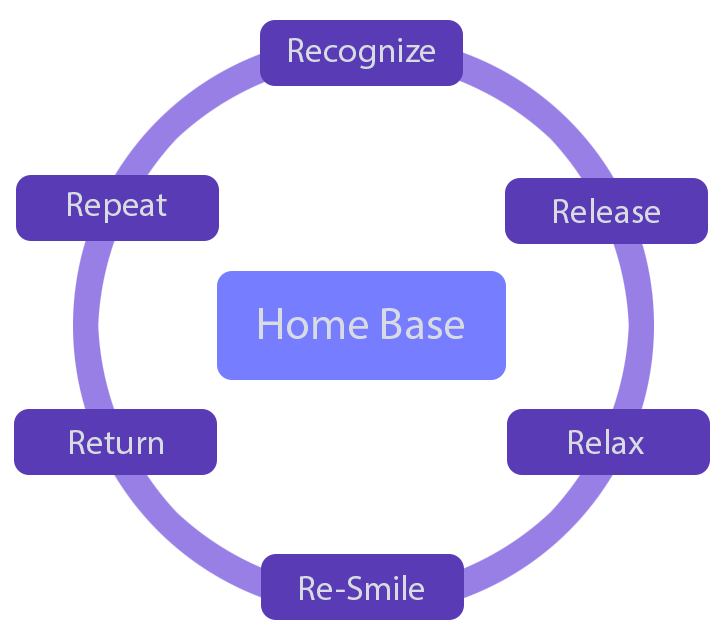Learn How to Meditate
Learn TWIM

Part A
Learn Home Base for Meditation
Meditation in the body
Begin by sitting comfortably in a quiet, private place where you won’t be interrupted. Sit on a pillow or a comfortable chair with your back naturally straight, but not stiff. Set timer for 30 minutes. Increate the time for better results. Close your eyes gently and commit to remaining still—no fidgeting or shifting.
Relax deeply, as if you were sinking into a warm bath or lying down to rest. Bring your awareness to your entire body. Soften your posture and release any tension—especially in the head, neck, and shoulders. Allow your body to settle. Let go of any control. Let the body breathe and relax naturally.
Meditation in the mind
Direct your attention to a warm, pleasant feeling of loving-kindness. It’s a feeling of friendliness and lightness in the mind and heart.
To spark this feeling, make a simple, sincere wish for your own well-being. For example:
“May I be kind.”
“May I be happy.”
“May I be peaceful.”
Make your wish be heartfelt and sincere. Feel the emotional tone of kindness arise, especially in the chest area. It may be strong or faint. Simply rest your attention on the feeling, gently and patiently with it for as long as it’s present.
Tips
If the feeling is difficult to bring up, try recalling a moment when you felt natural love or kindness—perhaps holding a baby, hugging a pet, or resting peacefully at sunset. Allow that joyful memory to bring a warm, open feeling into your heart. Smile softly. Let the mind and body bathe in this gentle warmth.
Allow the feeling to flow naturally, inward and outward, throughout your awareness. Don’t try to hold onto it or make it stronger. Relax into it. The intensity of the feeling will change—that’s normal. Be patient. Return your attention gently to the feeling whenever the mind wanders.
Make this this a warm, kind feeling for beginning the journey. Make meditation enjoyable:
Stay soft snd simile.

Part B
How to Deal with Distreactions
Meditation is often a struggle with mental distractions, restlessness, and disturbing thoughts and emotions. TWIM uses a step by step process to deal with distractions at all stages in meditation called the Six Rs. It’s a gentle, effective originated by the Buddha called Right Effort.
Take Action
The Six Rs method is a easy to learn action done step-by-step to de-condtion and gently dissolve distractions and retun to attention to your home base. Using the Six Rs avoids fighting or suppressing distracting emotions or thoughts.
Most distractions are Triggered by Craving
Craving is a urge to do or think something. It seems to happen instantly—but when the mind is quit and alert meditating—it can noticed when is first starts and grows stronger. The early signs of craving include:
• Tightness or tension in the head, neck, or shoulders
• Pressure in the head.
• Heat and stress in the body
• Restlessness or boredom
• Urges to do something or think
How does the Six Rs Transform Body and Mind?
Each time you apply the Six Rs, your attention is gently returned to present moment accompanied by comfort, happiness, and balance. With practive, your attention naturally remains collected with the sensation of loving-kindess (the meditation object) for longer and longer periods. This happen automatically through practice.
What does it for me?
• De-conditions craving–the urge to change or control thoughts, emotions, or sensations
• Cultivates joy (pīti), happiness (sukha), and tranquility (upekkhā)
• Develops stable attention, emotional balance, and clear awareness–natural collectedness (samādhi)
• Supports natural entry into the stages of meditative and unification of mind (jhānas)
The Six Rs: A Meditator’s Toolkit

Distractions aren’t failures—they’re doorways
TWIM uses a simple, repeatable method called the Six Rs to work skillfully with distractions. Think of it like mental reset software—clearing emotional static and restoring calm, joyful awareness.
Whenever you notice your attention has fully wandered from the feeling of loving-kindness, apply the Six Rs:
1. Recognize – that your awareness has become distracted away from home base.
2. Release – Let go and abandon the distraction without resistance.
3. Relax – Soften any tension in the body form head to toe, especially in the head, neck, and shoulders.
4. Re-Smile – Lightly smile to uplift the mind.
5. Return – Gently bring your attention back to the feeling of loving-kindness in your body.
6. Repeat – Use this process whenever you attention is completely distracted from home base.
This is the essence of Right Effort (Sammā Vāyā) in the Buddha’s Noble Eightfold Path. It’s not about control or force—it’s about releasing, relaxing, and returning with wisdom (reality)—to your home base.
Distractions are Your Teachers
The Six Rs is process of observing and releasing distractions through insight into the nature of cause and effect. Craving—whether physical, emotional, or mental—is not a personal flaw, but a conditioned reaction. Using the Six Rs, meditators learn to gently recognize, release, and relax these patterns. With practice, this method gradually de-conditions the root causes of distraction, leading to calm, clarity, joy, and ultimately, awakening.
When seen with wisdom, every distraction becomes a doorway to insight. With patience and practice, your meditation becomes less about fighting the mind and more about understanding it. This understanding leads to joy, calm, and ultimately—awakening.
Results You Can Feel
Every time you use the Six Rs, you weaken the roots of distraction and reinforce clarity, balance, and joy. Over time, this process naturally cultivates the Seven Factors of Awakening,
Mindfulness
Investigation
Energy
Joy
Tranquility
Collectedness
Equanimity
This is how insight deepens and awakening unfolds—not through struggle, but through understanding and ease.

Part C
How to Practice for Best Results
Practice is the Gateway to Relief
• Practice daily, ideally when you are alert and energized
• Choose a quiet, private space where you won’t be interrupted
• Sit very comfortably with a straight back in a chair or on a cushion
• Begin with 30 minutes, increasing practice time gradually
• Stay still during the session—motionlessness conditions clarity and open the mind to penetrating insight
• Follow along with the guided instructions in the YouTube video below
Why This Matters
Most meditation techniques result in temporary calm. TWIM is different becase you are training your mind to gently undo the root causes and conditions that lead to suffering through relaxed effort—not control. The Six Rs are the heart of “exactly how to meditate regradless or what your choose as your meditative home bae. practice, and they lead directly to lasting clarity, contentment, and awakening.

Part D
Epert Guidance and Instruction

Guided loving-kindness meditations with the Six Rs
—Venerable Bhante Vimalarmsi

Brief beginning metta meditation Instructions
— David Johnson
Learn the Beginning TWIM practice from Bhante Vimalaramsi in an mp3. Download it on your mobile and learning toht practice in home, the beach, or during a flight.

